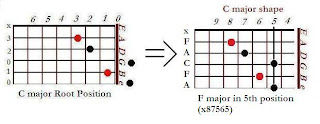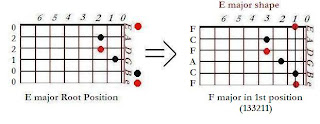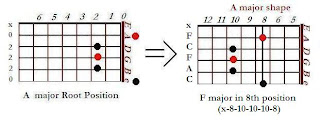The process is simple: Transposition. All you do is as follows:
- Choose a chord you wish to play. For our example, let us take F major
- Choose a shape you want to play F major in. You can play it in any of the five CAGED shapes. The commonly played versions utilize the C, the E and the A major shapes.
- Now, to play F major in the E major shape you must calculate the number of semitones in the ascending chromatic scale between the note that names the shape (C for C major, E for E major) and the note that names the chord (F for F major)
- In our examples, the intervals come as follows:
- F major in C major shape: 5 semitones (C-C#-D-D#-E-F)
- F major in E major shape: 1 semitone (E-F)
- F major in A major shape: 4 semitones (F#-G-G#-A)
- Now, to play F major in C major shape, hold down the basic C major shape and move it down the neck by 5 semitones (as calculated), as we did for the CAGED chords such as A major. To properly shift down the open string notes in C major, a bar must now be added. Thus F major in C major shape (x32010) becomes F major in 5th position - x87565.
- Similarly, for F major in E major shape, hold down the basic C major shape and move it down the neck by 1 semitone, adding the required bar in the process producing F major in 1st position (commonest version of F major - 133211)
- Finally, in a similar process, F major in A major position comes to be F major in 8th position, i.e. x-8-10-10-10-8
- In all of the above, you will note that the basic structure of the root note and other notes is the same as that in the original shape, i.e. the position of the root note is on the same string and so is the case for the M3 and P5 notes.
Using similar logic and techniques, we can derive any major chord from the five basic shapes.
For example:
- Db or C# can be played as x46664 or x43121, in A and C major shapes respectively
- A# or Bb can be played as x13331 (common form), in the A major shape
- Ab or G# can be played as 466344 (common form), in E major shape
- D# or Eb can be played as x68886 or x65343, in A and C major shapes respectively
- B major, again be played as x24442 (common form) or 799877 in A and E major shapes respectively
Another comprehensive example showing all major chords playable using any shape (here C major shape, for example) should clear up things more:
Major chords played using the C major shape:
| Chord in C major shape | Chord structure (in E to e pattern) |
| C major | x32010 |
| C# major | x43121 |
| D major | x54232 |
| D# major | x65343 |
| E major | x76454 |
| F major | x87565 |
| F# major | x98676 |
| G major | x-10-9-7-8-7 |
| G# major | x-11-10-8-9-8 |
| A major | x-12-11-9-10-9 |
| A# major | x-13-12-10-11-10 |
| B major | x-14-13-11-12-11 |
| C major (alternate shape) | x-15-14-12-13-12 |
Every chord in this list is formed by shifting the basic C major shape back by one semitone at a time, C to C# to D and so on. After completing the octave at B starting from C, we move back to C major again, as is the nature of the chromatic scale conferred upon it by 12-TET.
The CAGED System on a Guitar:
- Introduction to the CAGED system
- Fretboard layout
- Bar chords and movable shapes
- The basic 5 CAGED shapes
- CAGED Major chords: C Major, A Major, G Major, E Major, D Major
- Non-CAGED Major chords : F major, B major, C#, Eb, etc
- Principle of CAGED system
- CAGED Minor chords
- Fretboard note map
- Extended guitar chords
http://basicmusictheory.blogspot.com/2010/08/non-caged-chords-f-major-b-major-c-bb-g.html
Liked 'Non-CAGED major chords: F, B, C#, Bb, G#, Eb, D#, etc' enough to share / save?



Comments: 0 comment(s)...have your say!
Post your comment!